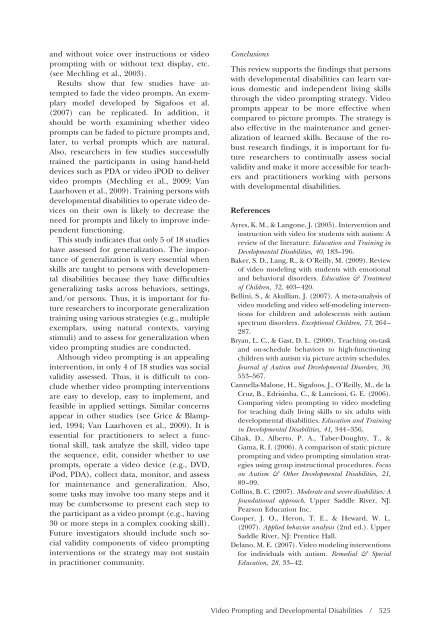etadd_46(4) - Division on Autism and Developmental Disabilities
etadd_46(4) - Division on Autism and Developmental Disabilities
etadd_46(4) - Division on Autism and Developmental Disabilities
You also want an ePaper? Increase the reach of your titles
YUMPU automatically turns print PDFs into web optimized ePapers that Google loves.
<strong>and</strong> without voice over instructi<strong>on</strong>s or video<br />
prompting with or without text display, etc.<br />
(see Mechling et al., 2003).<br />
Results show that few studies have attempted<br />
to fade the video prompts. An exemplary<br />
model developed by Sigafoos et al.<br />
(2007) can be replicated. In additi<strong>on</strong>, it<br />
should be worth examining whether video<br />
prompts can be faded to picture prompts <strong>and</strong>,<br />
later, to verbal prompts which are natural.<br />
Also, researchers in few studies successfully<br />
trained the participants in using h<strong>and</strong>-held<br />
devices such as PDA or video iPOD to deliver<br />
video prompts (Mechling et al., 2009; Van<br />
Laarhoven et al., 2009). Training pers<strong>on</strong>s with<br />
developmental disabilities to operate video devices<br />
<strong>on</strong> their own is likely to decrease the<br />
need for prompts <strong>and</strong> likely to improve independent<br />
functi<strong>on</strong>ing.<br />
This study indicates that <strong>on</strong>ly 5 of 18 studies<br />
have assessed for generalizati<strong>on</strong>. The importance<br />
of generalizati<strong>on</strong> is very essential when<br />
skills are taught to pers<strong>on</strong>s with developmental<br />
disabilities because they have difficulties<br />
generalizing tasks across behaviors, settings,<br />
<strong>and</strong>/or pers<strong>on</strong>s. Thus, it is important for future<br />
researchers to incorporate generalizati<strong>on</strong><br />
training using various strategies (e.g., multiple<br />
exemplars, using natural c<strong>on</strong>texts, varying<br />
stimuli) <strong>and</strong> to assess for generalizati<strong>on</strong> when<br />
video prompting studies are c<strong>on</strong>ducted.<br />
Although video prompting is an appealing<br />
interventi<strong>on</strong>, in <strong>on</strong>ly 4 of 18 studies was social<br />
validity assessed. Thus, it is difficult to c<strong>on</strong>clude<br />
whether video prompting interventi<strong>on</strong>s<br />
are easy to develop, easy to implement, <strong>and</strong><br />
feasible in applied settings. Similar c<strong>on</strong>cerns<br />
appear in other studies (see Grice & Blampied,<br />
1994; Van Laarhoven et al., 2009). It is<br />
essential for practiti<strong>on</strong>ers to select a functi<strong>on</strong>al<br />
skill, task analyze the skill, video tape<br />
the sequence, edit, c<strong>on</strong>sider whether to use<br />
prompts, operate a video device (e.g., DVD,<br />
iPod, PDA), collect data, m<strong>on</strong>itor, <strong>and</strong> assess<br />
for maintenance <strong>and</strong> generalizati<strong>on</strong>. Also,<br />
some tasks may involve too many steps <strong>and</strong> it<br />
may be cumbersome to present each step to<br />
the participant as a video prompt (e.g., having<br />
30 or more steps in a complex cooking skill).<br />
Future investigators should include such social<br />
validity comp<strong>on</strong>ents of video prompting<br />
interventi<strong>on</strong>s or the strategy may not sustain<br />
in practiti<strong>on</strong>er community.<br />
C<strong>on</strong>clusi<strong>on</strong>s<br />
This review supports the findings that pers<strong>on</strong>s<br />
with developmental disabilities can learn various<br />
domestic <strong>and</strong> independent living skills<br />
through the video prompting strategy. Video<br />
prompts appear to be more effective when<br />
compared to picture prompts. The strategy is<br />
also effective in the maintenance <strong>and</strong> generalizati<strong>on</strong><br />
of learned skills. Because of the robust<br />
research findings, it is important for future<br />
researchers to c<strong>on</strong>tinually assess social<br />
validity <strong>and</strong> make it more accessible for teachers<br />
<strong>and</strong> practiti<strong>on</strong>ers working with pers<strong>on</strong>s<br />
with developmental disabilities.<br />
References<br />
Ayres, K. M., & Lang<strong>on</strong>e, J. (2005). Interventi<strong>on</strong> <strong>and</strong><br />
instructi<strong>on</strong> with video for students with autism: A<br />
review of the literature. Educati<strong>on</strong> <strong>and</strong> Training in<br />
<strong>Developmental</strong> <strong>Disabilities</strong>, 40, 183–196.<br />
Baker, S. D., Lang, R., & O’Reilly, M. (2009). Review<br />
of video modeling with students with emoti<strong>on</strong>al<br />
<strong>and</strong> behavioral disorders. Educati<strong>on</strong> & Treatment<br />
of Children, 32, 403–420.<br />
Bellini, S., & Akullian, J. (2007). A meta-analysis of<br />
video modeling <strong>and</strong> video self-modeling interventi<strong>on</strong>s<br />
for children <strong>and</strong> adolescents with autism<br />
spectrum disorders. Excepti<strong>on</strong>al Children, 73, 264–<br />
287.<br />
Bryan, L. C., & Gast, D. L. (2000). Teaching <strong>on</strong>-task<br />
<strong>and</strong> <strong>on</strong>-schedule behaviors to high-functi<strong>on</strong>ing<br />
children with autism via picture activity schedules.<br />
Journal of <strong>Autism</strong> <strong>and</strong> <strong>Developmental</strong> Disorders, 30,<br />
553–567.<br />
Cannella-Mal<strong>on</strong>e, H., Sigafoos, J., O’Reilly, M., de la<br />
Cruz, B., Edrisinha, C., & Lanci<strong>on</strong>i, G. E. (2006).<br />
Comparing video prompting to video modeling<br />
for teaching daily living skills to six adults with<br />
developmental disabilities. Educati<strong>on</strong> <strong>and</strong> Training<br />
in <strong>Developmental</strong> <strong>Disabilities</strong>, 41, 344–356.<br />
Cihak, D., Alberto, P. A., Taber-Doughty, T., &<br />
Gama, R. I. (2006). A comparis<strong>on</strong> of static picture<br />
prompting <strong>and</strong> video prompting simulati<strong>on</strong> strategies<br />
using group instructi<strong>on</strong>al procedures. Focus<br />
<strong>on</strong> <strong>Autism</strong> & Other <strong>Developmental</strong> <strong>Disabilities</strong>, 21,<br />
89–99.<br />
Collins, B. C. (2007). Moderate <strong>and</strong> severe disabilities: A<br />
foundati<strong>on</strong>al approach. Upper Saddle River, NJ:<br />
Pears<strong>on</strong> Educati<strong>on</strong> Inc.<br />
Cooper, J. O., Her<strong>on</strong>, T. E., & Heward, W. L.<br />
(2007). Applied behavior analysis (2nd ed.). Upper<br />
Saddle River, NJ: Prentice Hall.<br />
Delano, M. E. (2007). Video modeling interventi<strong>on</strong>s<br />
for individuals with autism. Remedial & Special<br />
Educati<strong>on</strong>, 28, 33–42.<br />
Video Prompting <strong>and</strong> <strong>Developmental</strong> <strong>Disabilities</strong> / 525
















